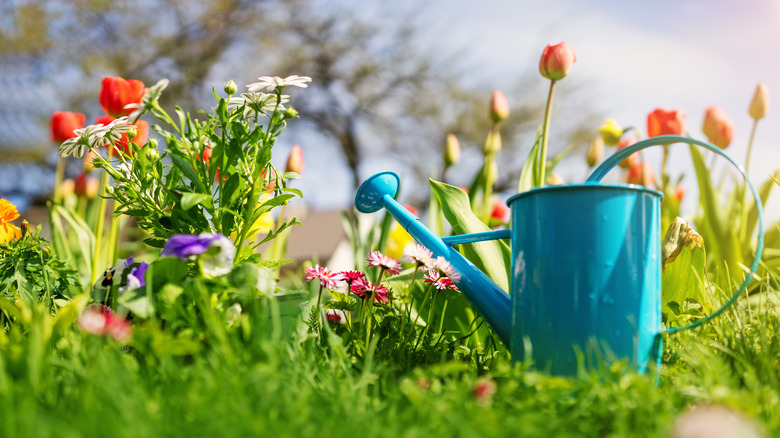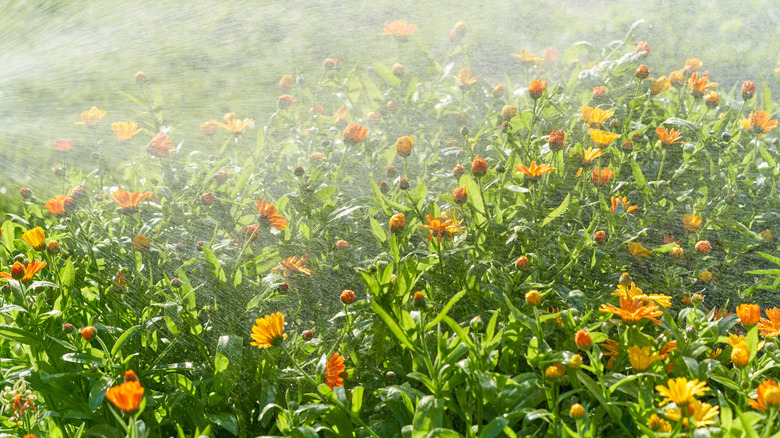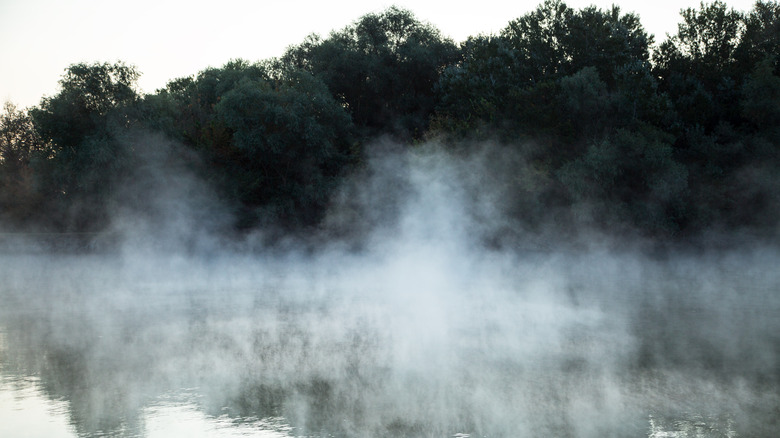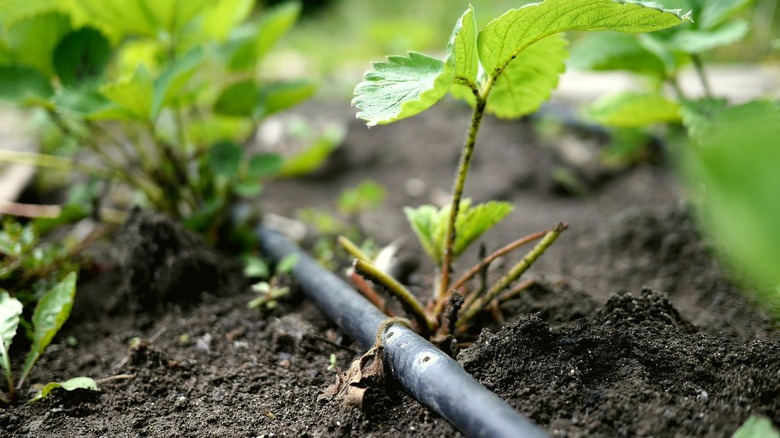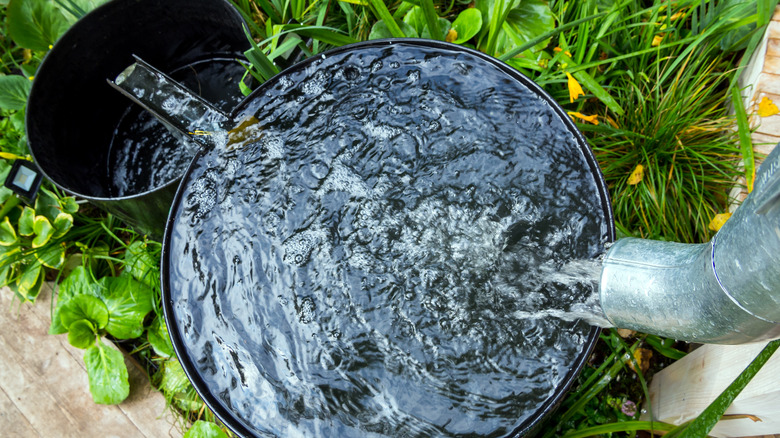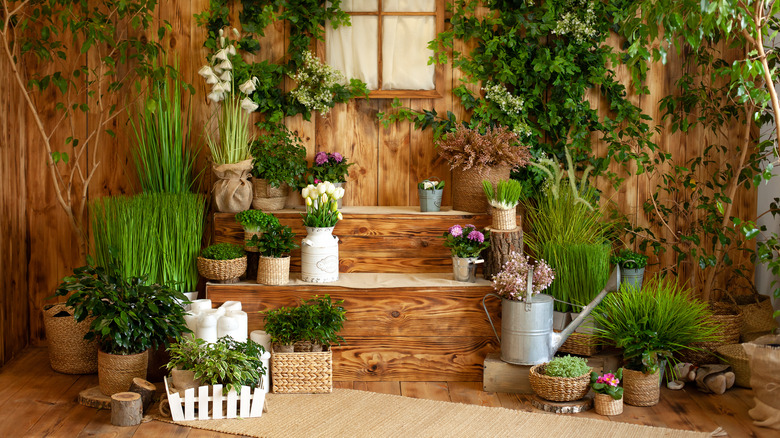You've Probably Been Watering Your Flower Beds All Wrong
Water is essential to life, for humans and plants. After all, aqua provides a necessary ingredient — along with soil and carbon dioxide — for photosynthesis, the chemical reaction that creates food for all flowers and greenery (via the BBC).
Plants, which are 90 percent water, according to UCSB Science Line, will also wilt if not hydrated properly. So watering your flower beds correctly is important to keep them green, healthy, and full of blooms. That act requires becoming something of an alchemist; the right watering formula is akin to magic because so much can go wrong. Too much water brings disease such as mold and fungus. Too little dries out your flower beds and can keep the plant's roots shallow rather than extending deep into the ground — no matter what variety you're cultivating. The perfect watering plan imitates that well-known Goldilocks fairytale: Everything should be "just right."
Finding that balance is challenging, but entirely possible. First, let go of your need to schedule the sprinkler for its usual regular dousing three days a week and learn how to treat your garden better. A few basics philosophies are the key to ensuring your flower beds will thrive all season long.
Don't use the wrong amount of water
Getting the best blooms requires the perfect amount of H2O, and the right balance lies somewhere between saturation and dryness. You want to keep the flower beds moist, but also allow the dirt to slightly dry out before re-watering to help promote root growth, according to Gardena. So sometimes, watering less frequently can become an asset, and the website suggests that one or two sessions with the sprinkler makes for healthy and happier flowers. Make sure that ample water is used — a thorough dousing should be fine for the flower bed until the next time the hose comes out.
To check if you've watered enough, try to determine how deep the fluid has penetrated into the ground. The water should always hit all sides of the roots so that they becomes strong. All kinds of factors interfere with this, including not watering enough, the type of soil used, or if the garden contains mulch. Garden Fundamentals recommends that the liquid goes down about six inches into the earth.
To figure out if your depth is sufficient, try digging a hole in the dirt after you water your plants. If the moistness is still there at the six inch-mark, consider the garden good to go ... at least for the time being.
Don't water at the wrong time of day
When you water your flower beds, evaporation happens. Remember that term from elementary school science class? This is when liquid transforms to vapor, journeying back up into the sky to eventually turn into rain, per the United States Geological Survey. While that's helpful for the circle of life, you want to retain the water in the soil so it nurtures your plants.
You can mitigate vaporization by paying attention to when you water your flower bed. When the soil is cooler, you lose less liquid. That means watering in the morning actually helps your plants retain all that lovely moisture, while preparing those blossoms to face the hot sun. So avoid those midday waterings when the sun beams down from its apex in the sky, a position that only fosters evaporation and promotes waste (via Gardena).
While watering in the evening does cool the soil down from summer's beating sunshine, late night water sessions done when warmth still lingers on the ground may promote fungal growth, rot, and can bring out the bugs, which will feast on you and your flower bed, according to HGTV.
Water soil, not leaves or flowers
Where you water matters. The best place to saturate your flower beds is at the source of life: the dirt, reported SF Gate. Sodden leaves actually can become diseased, developing mold or rot when the wetness meets the cool of night. So either avoid spraying them entirely or do so early enough in the day that the leaves can dry off (via Bonnie Plants).
Plants absorb water using their roots, according to the Chicago Tribune, and ensuring that the spray hits the ground allows more moisture into the earth. This helps develop roots, making them flourish and offshoot deeper. And this allows the plant to soak up even more water and retain its health — which will, in turn, create more of those bright flowers you want to see.
Bob Vila recommends using a soaker hose, which feature thousands of pores that allow the water to feed your flower beds slowly. These devices, which attach to regular spigots, let water drip directly into the soil using a regular flow of nurturing liquid without overwatering. Once you wend the hose through your flower beds, you simply turn on the hose until desired wetness is achieved. Mulching also helps keep water in the dirt, as noted by Gardeners Supply Company. Its thickness slows evaporation and the texture prevents run-off from otherwise exposed soil.
Don't forget to be environmentally conscious
A green-minded philosophy helps both your flower beds and the ecosystem. The first thing you can do to keep your flower beds — and the earth — happy is to plan your watering schedule to optimize growth, but minimize waste. A moisture sensor or meter can help inform you exactly how much liquid is needed. Guesswork often leads to either water-logging the area (which hurts your plants because their roots cannot breathe and oxygen is essential for photosynthesis) or under-watering your flower beds. The meter lets you know how dry your soil is getting so you can make better, more efficient decisions about your watering timetable (via The Good Earth Garden).
You can also conserve water by collecting rainwater in barrels. You can divert water into these containers by using a downspout, which is attached to your gutter or to another receptacle, suggested Wild Abundance. To avoid debris like leaves or acorns from clogging the downspout, consider adding a filter or screen to the top of it. The system will fill up the drum, which you can then use to water your flower beds. Like the downspout, the drum can gather other unwanted items besides liquid and a screen on top prevents that. It'll also keep out any mosquitos attracted to the large pool of water.
Don't forget to water containers frequently
Containers are an extension of your garden — and you can create a flower bed of sorts by clustering them together in spaces that don't normally have soil. One thing you need to keep in mind, though, is such pots retain heat — so pay attention to how often you water them. Plus, their design limits dirt space and that impacts moisture storage. Check the potting soil daily with your finger and if you find the first inch of it dry, pull out that watering can and give it some of that nurturing liquid. Containers, like your more permanent flower gardens, flourish when you water in the early morning or evening, which limits excess water from collecting around the plant, making it susceptible to disease (per Gardening Know How].
You also want to use soil specific to the type of flower residing in the pot. Cactus plants and succulents do better in potting soil that adds sand to its mix because it keeps the environment drier by draining more quickly. Moisture control potting soil uses more peat moss that allows the dirt to stay wetter, perfect for many vegetables and annuals. Some soils even have fertilizer that time-releases nutrients into the plant, according to The Spruce.
Take good care of all your flower beds and, in appreciation, all the plants will bloom and provide color and sweet scents all season long.
